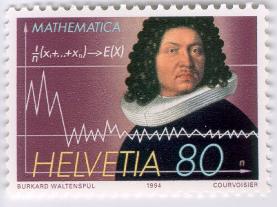
|
|
A Bibliography of Bernoulli Numbers
by
Karl Dilcher
dilcher@mscs.dal.ca
Department of Mathematics and Statistics
Dalhousie University
Halifax, Nova Scotia, B3H 3J5, Canada
(902) 494-3784
and
Ilja Sh. Slavutskii
str. Hamarva 4
P.O.B. 23393
Akko, Israel
|

|
Last update: March 3, 2007
See the newest additions
Please select the initial letter of author's last name
This bibliography originated from a private list of I. Sh. Slavutskii
which was subsequently completed and organized by L. Skula in Brno, Czech
Republic, and was published as "Bernoulli numbers. Bibliography
(1713-1983)" by L. Skula and I. Sh. Slavutskii, J. E. Purkyne
University (now Masaryk University), Brno, 1988. A new edition was
later published as "Bernoulli numbers. Bibliography (1713-1990)"
by K. Dilcher, L. Skula and
I. Sh. Slavutskii,
Queen's Papers in Pure and Applied Mathematics, No. 87,
Kingston, Ontario, 1991. It was the TeX file for this publication and
later supplements which served as the basis for the present electronic
version.
The present bibliography will be regularly updated. However, we did not
include the subject index (which was actually only a title keyword index)
of the 1991 printed edition. We suggest that the search function of the user's
web browser be used for this purpose. It will be best to use the
complete file for this purpose
(but it is quite large: 497k).
We welcome comments, suggestions and corrections, and especially references
to books or papers we may have missed. Please send comments by e-mail to
K. Dilcher, dilcher@mscs.dal.ca,
or by regular mail to either of us.
In December, 2005, this bibliography contained 2970 entries by
1493 authors.
The Bernoulli numbers are among the most interesting and important number
sequences in mathematics. They first appeared in the posthumous work
"Ars Conjectandi" (1713) by Jakob Bernoulli (1654-1705) in connection
with sums of powers of consecutive integers (see Bernoulli (1713)
or D.E. Smith (1959)). Bernoulli numbers are particularly important in number
theory, especially in connection with Fermat's last theorem (see, e.g.,
Ribenboim (1979)). They also appear in the calculus of finite differences
(Nörlund (1924)), in combinatorics (Comtet (1970, 1974)), and in other
fields.
Definitions and main properties of Bernoulli numbers can be found in a great
number of articles and books listed in this bibliography. Good introductions
are given, e.g., in Ireland and Rosen (1982, 1990), Rademacher (1973), and
Nörlund (1924).
A handy collection of formulas is in Abramowitz and Stegun (1964). Some older
books are entirely devoted to Bernoulli numbers; among them are Chistyakov
(1895), Nielsen (1923), and Saalschütz (1893). One should, however, be
aware of possible differences in notation and indexing, especially in older
publications.
The number sequences of Euler, Genocchi, Stirling and others, as well as the
tangent numbers, secant numbers, etc., are closely related to the Bernoulli
numbers. We have therefore included many publications dealing with these
number sequences. The same is true for the numerous generalizations and
extensions of the Bernoulli and allied numbers and of the corresponding
polynomials. However, from the vast literature on Stirling numbers (and some
other topics) we included only those articles that appeared to be quite
close to the topic of this bibliography.
Basically, this bibliography contains papers that (i) deal primarily with
Bernoulli numbers and related number and polynomial sequences, and (ii) those
in which these numbers and polynomials are applied. In the first category
we tried to be as complete as possible. However, there are probably many
papers we have missed. As far as the second category is concerned, we were
faced with two problems. First, because of the vast number of articles in
which Bernoulli and related numbers occur in one way or another (e.g.,
through the Euler-Maclaurin formula), it would have been unreasonable to
attempt including them all. We included those in which Bernoulli numbers
play a relatively important role; these criteria, however, are not well
defined and are somewhat arbitrary. Second, it is almost impossible to
identify all papers dealing with applications of Bernoulli numbers. Also, the
focus of this bibliography is somewhat slanted toward number theory,
the main field of our interest and expertise.
There are no clear rules concerning translations of titles from languages
other than English. Titles in English, French, and German have usually been
left in their original. While in the 1991 printed edition most Russian titles
were given both in their original and in English translation, here they appear
only in translation (as they appear in Mathematical Reviews), or in some
cases in transliteration. Titles in other languages are usually given
as they were found in the sources. This may mean the original alone, or the
English translation, or sometimes both. In some cases, titles are given
only in German translation. In the present version, some accents or diacritical
marks may not appear correctly, or not at all.
Most entries of this and the previous printed editions were taken from the
following sources:
- Mathematical Reviews
- MathSciNet (the electronic version of Math. Reviews)
- Zentralblatt für Mathematik und ihre Grenzgebiete
- Referativnii Zhurnal - Matematika
- Jahrbuch über die Fortschritte der Mathematik
- Reviews in Number Theory (1940--1972), edited by William J. LeVeque,
American Mathematical Society, 1974.
- Reviews in Number Theory (1973--1984), edited by Richard K. Guy,
American Mathematical Society, 1984.
- History of the Theory of Numbers, 3 Vols., by L.E. Dickson, Washington, 1919-1923.
Among other useful sources and references are the following publications:
- CompuMath Citation Index, Institute for Scientific Information,
Philadelphia, PA, (1980 -- ).
- The Royal Society of London Catalogue of Scientific Papers (1800--1900).
- An Index of Mathematical Tables, Vol. I, II, by A. Fletcher et al.,
Addison-Wesley, Reading, Mass., 1962.
- Index to the American Mathematical Monthly, Vol. 1--80,
Mathematical Association of America, Washington.
- A Handbook of Integer Sequences, by N.J.A. Sloane,
Academic Press, New York, 1973. (See also Sloane and Plouffe (1995)).
- A Table of Series and Products, by Eldon R. Hansen, Prentice-Hall,
Englewood Cliffs, N.J., 1975.
- Biblioteca Mathematica by Erlecke, 1871.
Furthermore, a good number of older papers that were previously unknown to
us were found in the Mittag-Leffler offprint collection at the University
of Lund, Sweden. A bibliography of that collection is now available from
Jaak Peetre of the Universtiy of Lund. Another set of older papers, added
in August, 2001, is from the unpublished Bibliography Vandiver [56].
- J
- Jahrbuch über die Fortschritte der Mathematik (1868-1942)
- M
- Mathematical Reviews (1940- )
- R
- Referativnii Zhurnal - Matematika (1953- )
- Z
- Zentralblatt für Mathematik und ihre Grenzgebiete (1931- )
Names of journals are mostly abbreviated in accordance with the style used
by Mathematical Reviews. A list of abbreviations can be found in any author
index of M . No unified system of abbreviations was attempted with
older journals; most appear as quoted in the sources.

